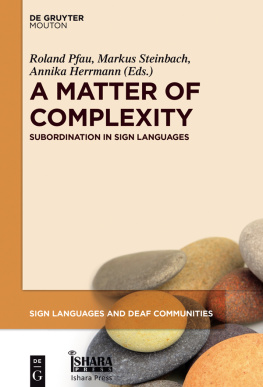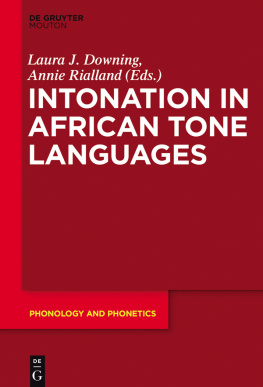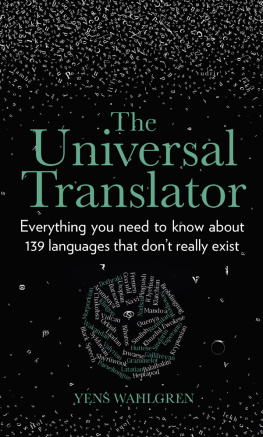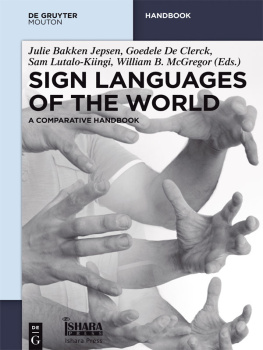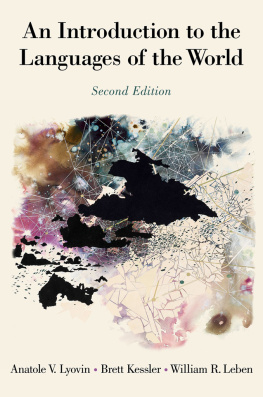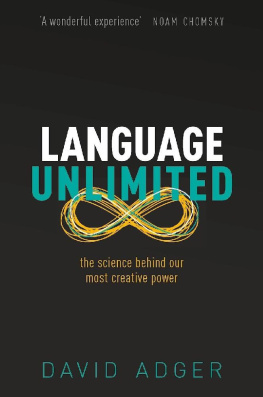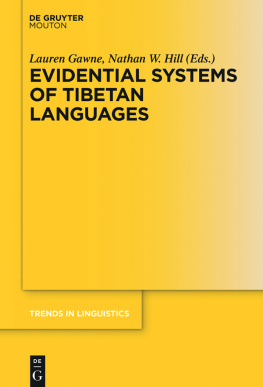
A Matter of Complexity
Sign Languages and Deaf Communities 6
Editors
Annika Herrmann
Markus Steinbach
Ulrike Zeshan
Editorial board
Carlo Geraci
Rachel McKee
Victoria Nyst
Sibaji Panda
Marianne Rossi Stumpf
Felix Sze
Sandra Wood
De Gruyter Mouton Ishara Press

ISBN 978-1-5015-1133-2
e-ISBN (PDF) 978-1-5015-0323-8
e-ISBN (EPUB) 978-1-5015-0301-6
ISSN 2192-516X
e-ISSN 2192-5178
Library of Congress Cataloging-in-Publication Data
A CIP catalog record for this book has been applied for at the Library of Congress.
Bibliographic information published by the Deutsche Nationalbibliothek
The Deutsche Nationalbibliothek lists this publication in the Deutsche Nationalbibliografie; detailed bibliographic data are available on the Internet at http://dnb.dnb.de.
2016 Walter de Gruyter Inc., Boston/Berlin and Ishara Press, Preston, UK
www.degruyter.com
Notational conventions
We follow the notational conventions in Pfau et al. (2012). In all examples as well as in the text, signs are glossed in small caps (SIGN). Glosses are usually in English. With respect to manual signs, the following notation conventions are used.
| INDEX/IX | pointing sign used in pronominalization and for localizing non-present referents and locations in the signing space. The subscript numbers refer to points in the signing space and are not necessarily meant to reflect person distinctions: 1 = towards signer's chest, 2 = towards addressee; 3a/3b = towards ipsi- or contralateral side of the signing space. |
| 1SIGN3a s-i-g-n SIGN^SIGN | verb sign moving in space from one location to another. represents a fingerspelled sign. indicates either the combination of two signs in a compound, e.g. MONK^BOSS 'abbot', or a sign plus affix/clitic combination (e.g. KNOW^NOT); in both types of combinations, characteristic assimilation and/or reduction processes may apply. |
| SIGN-SIGN | indicates that two words are needed to gloss a single sign (e.g. TWO-DAYS-AGO). |
| SIGN++ | indicates reduplication of a sign to express grammatical features such as plurality (e.g. BOOK++) or aspect (e.g. iterative or durative aspect). |
| CL | indicates the use of a classifier handshape that may combine with verbs of movement and location. |
Lines above the glosses indicate the scope, that is, the onset and offset of non-manual markers. The following notation conventions are used to distinguish different non-manual markers:
| / xxx/ | lexical marker: a mouthing (silent articulation of (part of) a spoken word) associated with a sign; |
| xxx | lexical or morphological marker: a mouth gesture associated with a sign; |
| top/t | syntactic topic marker; |
| wh | syntactic wh-question marker; |
| y/n | syntactic yes/no-question marker; |
| rel | syntactic relative clause marker; |
| neg | syntactic negation marker; |
| hs | headshake; |
| hn | headnod; |
| re/br | raised eyebrows / brow raise; |
| bf/bl | furrowed eye brows / brow lowering. |
When necessary, additional conventions are introduced in the respective chapter.
Sign language acronyms
| ASL | American Sign Language |
| CisSL | Cistercian Sign Language |
| DGS | German Sign Language (Deutsche Gebrdensprache) |
| HKSL | Hong Kong Sign Language |
| HSL | Hausa Sign Language |
| HZJ | Croatian Sign Language (Hrvatski Znakovni Jezik) |
| ISL | Israeli Sign Language |
| KSL | Kenyan Sign Language |
| LIBRAS | Brazilian Sign Language (Lingua de Sinais Brasileira) |
| LIS | Italian Sign Language (Lingua Italiana dei Segni) |
| LIU | Jordanian Sign Language (Lughat il- Ishaara il-Urdunia) |
| LSC | Catalan Sign Language (Llengua de Signes Catalana) |
| NGT | Sign Language of the Netherlands (Nederlandse Gebarentaal) |
| GS | Austrian Sign Language (sterreichische Gebrdensprache) |
| PISL | Plains Indian Sign Language |
| TD | Turkish Sign Language (Trk aret Dili) |
Complex sentences in sign languages: Modality typology discourse
Roland Pfau and Markus Steinbach
Abstract
Sign language grammars, just like spoken language grammars, generally provide various means to generate different kinds of complex syntactic structures including subordination of complement clauses, adverbial clauses, or relative clauses. Studies on various sign languages have revealed that sign languages use modality-independent strategies, i.e. strategies which are also available in spoken languages, to mark such complex subordinated structures. However, complex clauses in sign languages also display some interesting modality-specific properties, which are not attested in spoken languages. Therefore, the study of complex syntactic structures in the visual-gestural modality adds to our understanding of linguistic variation in the domain of subordination. Moreover, it offers new empirical and theoretical evidence concerning possible structures and functions of complex sentences in natural languages. In this introductory chapter, we focus on five aspects relevant to the investigation of subordinated clauses complexity, modality, typology, discourse, and grammaticalization and sketch how the study of subordinate structures in sign languages contributed, and still contributes, to the field of sign language linguistics and linguistic typology .
Introduction
According to a long-standing linguistic tradition, recursivity is a hallmark of natural languages (Hauser et al. 2002), next to other defining features such as, for instance, duality of patterning (Hockett 1960) and anaphoric reference. Recursivity implies that a certain rule can reapply to a construction that has itself been derived by that rule; for instance, a verb may take a sentence as complement, which in turn contains a verb with a sentential complement, and so forth. level is a language universal has been challenged (Everett 2005; Evans & Levinson 2009). Still, irrespective of the question whether the alleged universality of recursivity holds up to typological scrutiny, it is certainly true that most spoken languages allow for recursivity at the clausal level, that is, for some sort of subordination. It would therefore be rather surprising if visual-gestural languages as a group did not allow for this type of grammatical complexity and indeed, previous studies have shown for a number of sign languages that such complex structures do exist. This is not to say, however, that all sign languages would necessarily feature all types of subordinate structures we simply don't know this yet. What previous findings lead us to expect is that sign languages vary from each other in this domain, just like spoken languages do. The studies compiled in this volume contribute to identifying what is possible in individual sign languages and what is not.
Let us illustrate some of the points to be addressed in this chapter by means of the following, slightly exotic, example from Cistercian Sign Language (CisSL), a monastic sign language used in St. Joseph's Abbey in Spencer, Massachusetts (Barakat 1975: 134). We refer to example (1) as "slightly exotic" because CisSL is a so-called 'secondary sign language', that is, a sign language that has been developed by hearing people in this case, to obey a vow of silence. At least some secondary sign languages are characterized by a rather simple structure and by considerable influence of the surrounding spoken language (see Pfau (2012) for details). Consider, for instance, the use of the sign TWO for the (homonymous) infinitival marker to a strategy that one would not expect to find in a deaf community sign language. Still, the example is informative as it appears to involve subordination and coordination, marked in a way that is clearly different from English. First, the example contains the predicate KNOW which seems to take a wh-complement. This complement is introduced by the noun RULE, which could therefore be argued to have undergone grammaticalization.
Next page
